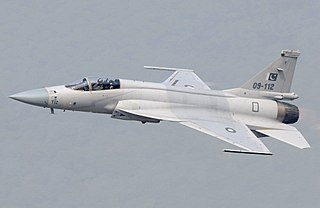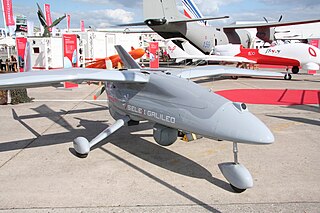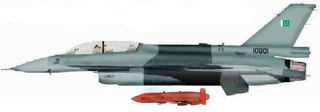Related Research Articles

A cruise missile is a guided missile used against terrestrial or naval targets, that remains in the atmosphere and flies the major portion of its flight path at an approximately constant speed. Cruise missiles are designed to deliver a large warhead over long distances with high precision. Modern cruise missiles are capable of traveling at high subsonic, supersonic, or hypersonic speeds, are self-navigating, and are able to fly on a non-ballistic, extremely low-altitude trajectory.

The Crotale is a French, all-weather, short-range surface-to-air missile system developed to intercept airborne ranged weapons and aircraft, from cruise or anti-ship missiles to helicopters, UAVs or low-flying high-performance fighter aircraft. It was developed by Thomson CSF Matra and consists of a mobile land-based variant as well as various naval ones.

An air-to-surface missile (ASM) or air-to-ground missile (AGM) is a missile designed to be launched from military aircraft at targets on land or sea. There are also unpowered guided glide bombs not considered missiles. The two most common propulsion systems for air-to-surface missiles are rocket motors, usually with shorter range, and slower, longer-range jet engines. Some Soviet-designed air-to-surface missiles are powered by ramjets, giving them both long range and high speed.

The CAC/PAC JF-17 Thunder, or FC-1 Xiaolong, is a lightweight, single-engine, multirole combat aircraft developed jointly by the Pakistan Aeronautical Complex (PAC) and Chengdu Aircraft Corporation (CAC) of China. It was designed and developed as a fourth-generation replacement for the third-generation A-5C, F-7P/PG, Mirage III, and Mirage V combat aircraft in the Pakistan Air Force (PAF). The JF-17 can be used for multiple roles, including interception, ground attack, anti-ship, and aerial reconnaissance. The Pakistani designation "JF-17" stands for "Joint Fighter-17", with the "Joint Fighter" denoting the joint Pakistani-Chinese development of the aircraft and the "-17" denoting that, in the PAF's vision, it is the successor to the F-16. The Chinese designation "FC-1" stands for "Fighter China-1".

The Popeye is a family of air-to-surface missiles developed and in use by Israel, of which several types have been developed for Israeli and export users. A long-range submarine-launched cruise missile variant of the Popeye Turbo has been speculated as being employed in Israel's submarine-based nuclear forces. The United States operated the Popeye under a different designation according to US naming conventions as the AGM-142 Have Nap.

The National Engineering & Scientific Commission (NESCOM) is a Pakistani government-funded defense contractor that develops, designs and sells defense hardware, including missile and weapon systems. It was funded and formed by the Government of Pakistan to develop its domestic production of weapon system.

The Pakistan Aeronautical Complex (PAC) is a major defense contractor and an aerospace manufacturer that is headquartered in Kamra, Punjab, Pakistan.
National Defence Complex (NDC), (Urdu: مستقرِ قومی دفاع) also known as National Development Complex, National Development Centre, is a Pakistani state-owned defence and aerospace contractor which is a division under the National Engineering and Scientific Commission (NESCOM). It's main setup is based in Fateh Jang, Rawalpindi, Pakistan.
Standoff weapons are missiles or bombs which may be launched from a distance sufficient to allow attacking personnel to evade the effect of the weapon or defensive fire from the target area. Typically, they are used against land- and sea-based targets in an offensive operation. The name is derived from their ability to engage the target while standing off outside the range at which the defenders are likely to engage the attacker. Typical stand-off weapons include cruise missiles, glide bombs and short-range ballistic missiles.

The KLJ-7, also referred to as the Type 1478, is an X band airborne fire-control radar (FCR) developed by Nanjing Research Institute of Electronic Technology (NRIET), also known as the China Electronics Technology Company's (CETC's) No. 14 Research Institute. In December 2010, Pakistan Air Force's Air Chief Marshal Rao Qamar Suleman announced that KLJ-7 radar will be built at Pakistan Aeronautical Complex (PAC), in Kamra, north of Islamabad.
The H-2 SOW is a precision-guided glide bomb manufactured by NESCOM and deployed by the Pakistan Air Force, capable of striking targets at stand-off range. It has a terminal guidance system based on an infra-red imaging seeker which identifies the target during the final stage of flight. Designed to hit targets out to 60 km, the bomb may be able to evade radar.

The Falco is a tactical unmanned aerial vehicle (UAV) designed and produced by Selex ES. The UAV is designed to be a medium-altitude, medium-endurance surveillance platform capable of carrying a range of payloads, including several types of high-resolution sensors. A larger variant, the Falco EVO, is capable of carrying larger payloads is also available. Neither system is designed to carry weapons, The launch customer, Pakistan, reportedly wanted the Falco armed, a request that Italy rejected.
Jasoos is an unmanned aerial vehicle designed and manufactured by SATUMA of Pakistan. The Jasoos II Bravo+ variant is currently operational with the Pakistan Air Force.

The HESA Karrar is an Iranian jet-powered target drone manufactured by Iran Aircraft Manufacturing Industrial Company (HESA) since 2010. The Karrar is a derivative of the American 1970s-era Beechcraft MQM-107 Streaker target drone, probably incorporating elements from the South African Skua, with hardpoints added for munitions. The Karrar was developed during the Ahmadinejad presidency.

The Ra'ad, is a subsonic, standoff, and an air-launched cruise missile (ALCM) designed and jointly developed by the National Engineering & Scientific Commission (NESCOM) and Pakistan Air Force's Air Weapons Complex.
Ra'ad is an Iranian designed and built subsonic anti-ship cruise missile. The missile is a reverse engineered and upgraded variant of China's Silkworm anti-ship missile. The missile was developed by the state-run Iran Aviation Industries Organization (IAIO). Iran reportedly began full production of the Ra’ad in January 2004 and went into service in 2007. The missile is equipped for ground and ship-launched platforms.
The Ra'ad-II is a standoff and an air-launched cruise missile (ALCM) derived from the Hatf-VIII Ra'ad. It was first publicly unveiled on the Pakistan Day Parade on 23 March 2017,
The Shahpar-ll is an unmanned combat aerial vehicle (UCAV) built by Global Industrial Defence Solutions of Pakistan. It is currently in production following the completion of a test and qualification phase.
References
- 1 2 "Kamra". Federation of Atomic Scientists.
- 1 2 Pike, John. "Kamra - Pakistan Special Weapons Facilities". www.globalsecurity.org.
- ↑ Doug Richardson, “Pakistan tests Hatf 8 air-launched cruise missile,” Jane’s Missiles and Rockets, 1 September 2007; “Pakistan missile test,”
- ↑ "Air Weapons Complex (AWC) | Facilities | NTI". www.nti.org. NTI Air. Retrieved 21 August 2020.
- ↑ "Air Weapons Complex, Pakistan". articles.janes.com. Archived from the original on 11 August 2011.
- ↑ "Defense & Security Intelligence & Analysis: IHS Jane's - IHS". articles.janes.com. Archived from the original on 11 August 2011.
- ↑ "Hafr-1 and -2 RBP-1 Runway Penetration Bomb, Pakistan". Archived from the original on 17 June 2011. Retrieved 11 May 2011.
- ↑ "Pakistan tests ballistic missile". BBC News. 29 April 2011.
- ↑ "Bangladesh adopts Pakistan-made air defence system". Pakistan Times (pakistantimes.net). Archived from the original on 7 January 2009. Retrieved 27 May 2011.
- ↑ "Article 4". Archived from the original on 28 July 2014. Retrieved 30 April 2013.
- ↑ "Defense & Security Intelligence & Analysis: IHS Jane's - IHS". articles.janes.com. Archived from the original on 2 April 2012.
